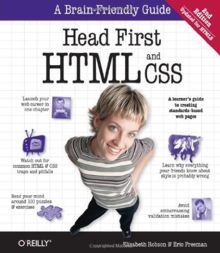| Head First HTML and CSS, 2nd Ed |
|
Author: Elisabeth Robson and Eric Freeman Head First books are designed to get you started. How far does this one go with HTML and CSS? If you know the format of Head Start books, it will not come as a shock to discover that this book is a mixture of different attempts to get you to understand the topic. However, Head Start books cover topics that vary in their suitability for the approach. In this case HTML and CSS are simple enough to make a simple approach work. If you are a complete beginner then this might be what you are looking for.
It starts out with a quick introduction to the idea of a web server and what an HTML page is all about. Then it moves on to explaining links and some basic tags. At this point you have the idea that a page is marked up using opening and closing tags. Chapter 4 then goes back over the basics of using a web server but in more practical detail including a mention of FTP and HTTP. The next topic is using media, or more precisely images. What format to use and how to get them into a page. Chapter 6 rounds out the HTML section of the book with a look at what HTML is, what HTML5 is and where it is all going. Chapter 7 starts the CSS part of the book and it explains the idea of using CSS to define how the HTML you have been learning about is displayed. In this chapter you learn the basics of CSS including selectors. The next chapter expands this to include fonts and colors - including hex codes. From here things get more complicated quite quickly. The next three chapters deal with the box model and how to control the layout using float. Chapter 12 is where you might find that things go a little wrong. This introduces HTML5 and the way things should be done in modern style. Perhaps it would have been better to use HTML5 from the start but you also need to know how things were done before HTML5. In the main, the general principles are the same so no great harm is done but it might irritate some readers to learn the old before the new. Chapter 13 deals with tables and chapter 14 deals with forms. Chapter 15 is honest enough to make a list of what hasn't been covered. Mostly this is fine but there is an entry in the list that might make you think about the logic of the entire book - item 7 - tools for creating web pages. Most people don't create complex web pages by entering HTML/CSS directly. The main use of knowledge of HTML/CSS is in editing what page creation tools create. If at all possible you probably should even avoid making such manual edits because this breaks the use of the construction tool. The problem is how do you learn enough HTML/CSS to understand what is going on? This book does tend to give the reader the impression that building a web page is a matter using a text editor to create HTML/CSS and this is probably inappropriate. The main thing to know about this book is that it is very slow in parts, mainly at the start and it repeats itself. It also tends to jump to new material as and when an example requires it but over all the pace is slow. If you are looking for a book that spoonfeeds you HTML/CSS then this might suit but if you have any functioning neurons try something a little more ambitious. Further Reading
|
|||
| Last Updated ( Saturday, 05 January 2013 ) |

